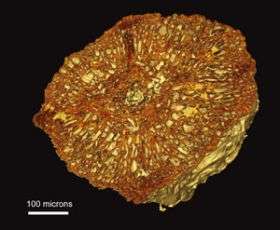The early relatives of flowering plants

The emergence of flowering plants is regarded as a major botanical mystery. In today’s edition of the scientific magazine Nature, an international research team with participation from the Paul Scherrer Institute (PSI) publishes results that shed fresh light on this controversial question. New three-dimensional non-destructive imaging procedures have been used for the first time to carry out investigations into fossilised plant seeds. As a result, it has been possible to confirm an earlier scientific theory, which had previously been cast into doubt by molecular genetic analyses.
This quest is like the search for the Holy Grail: botanists have puzzled for over a hundred years over how flowering plants (currently the group of plants with the richest range of variety) could have come into being, about 130 million years ago. The main cause of contention is that molecular genetic investigations produce solutions that conflict with those produced by phenomenological investigations.
Gnetophytes, which are coned, seed-bearing plants, play a pivotal role in this discussion. Only a few exotic types of these plants still exist, but a study of the morphology of the varieties still living today, together with the remains of fossil plants from geological eras, produces many indications that gnetophytes are closely related to flowering plants, and to the bennettitales, an extinct, species-rich group of plants.
These three groups form the super-group (clade) known as the anthophytes. On the other hand, genetic investigations indicate that gnetophytes are related to conifers. The correct classification of the various groups is critical, since this will allow deductions to be made about the development history of flowering plants.
Results now achieved by the international research team, in which PSI is involved, support the previously discredited anthophyte hypothesis. The scientists investigated fossilised plant seeds from Portugal and North America. In this case, the remains were carbonised, but still extremely well preserved, and were between 70 and 120 million years old. At that time, there were many more types of plant alive on Earth than there are now. These extinct varieties represent a hitherto neglected treasure trove, which can provide us with completely new insights into the relationships between the different groups of plants.
In this study, scientists used the TOMCAT beamline at the PSI Swiss Light Source (SLS) to analyse the seeds. With the help of a new phase-contrast method – called MBA – they were able to portray the internal structure of the seeds without destroying them. In contrast to conventional microtomography using synchrotron radiation, the phase-contrast method is based on diffraction of the X-rays. It provides clear and precise visualization of the sample, even when the absorption contrast is poor. This method has been well recognised at PSI for a long time, but researchers are now reaping the benefit of some marked improvements. In the past, each individual measurement took several hours, compared with just a few minutes today.
The images of the fossil seeds confirm that gnetophytes, bennettitales and flowering plants all share many similar characteristics, and this means that they must be closely related. These three groups of plants thus share common ancestors, which had split away from the conifers (such as firs, spruces and pines) before the evolution of true flowering plants.
Citation: Nature, Volume 450, Number 7169, 22 November 2007
Source: Paul Scherrer Institute


















